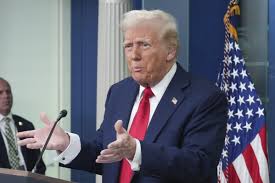Since returning to the White House, President Donald Trump has wasted no time in reshaping the U.S. government. His latest move? A bold offer to civil servants: take a buyout and leave voluntarily, or brace for an uncertain future.
On Tuesday, the Office of Personnel Management (OPM) sent an email to federal employees announcing a new “deferred resignation” program. Civil servants have until February 6 to decide whether they want to accept an eight-month salary severance package and exit their positions. This initiative, published under the ominous title ‘Fork in the Road’ on the OPM website, is just one in a series of sweeping reforms designed to restructure the federal workforce.
Trump’s Vision for a Leaner, More Loyal Government
Trump’s return to office has been marked by an aggressive push to streamline the federal government. Among the changes already announced:
- Return to Office Mandate – A full reversal of remote work policies, requiring federal employees to return to the office five days a week.
- Performance Overhaul – New, stringent performance standards aimed at fostering “excellence at every level.”
- Civil Service Restructuring – Downsizing the bureaucracy by converting career officials into political appointees, making their jobs more directly tied to administration priorities.
- Behavioral Standards Revamp – Employees must now demonstrate unwavering “reliability, loyalty, and trustworthiness” in their daily work.
Read also: What You Need to Know About Deepseek-R1 and How It’s Disrupting the AI World!
OPM has acknowledged that while it appreciates those who choose to stay, it cannot guarantee job security. For those who remain, the agency simply stated: “Should your position be eliminated, you will be treated with dignity and afforded all applicable protections.”
For workers opting into the buyout, there’s a silver lining: they will be exempt from in-person work requirements until their departure on September 30.
A Target of 10% Workforce Reduction
According to CBS News, the administration anticipates that up to 10% of the estimated 3 million federal employees will accept the buyout. This is just one component of Trump’s broader strategy to overhaul the federal workforce, an effort he framed in his inauguration speech as a mission to “restore competence and effectiveness.”
The Birth of the Department of Government Efficiency (DOGE)
As part of his efficiency drive, Trump has also greenlit the creation of the Department of Government Efficiency, commonly referred to as DOGE. This newly formed entity will spearhead federal modernization efforts, focusing on digital transformation and inter-agency collaboration.
One of its first actions? Rebranding the United States Digital Service (USDS) as the United States DOGE Service. This new agency, reporting directly to the White House Chief of Staff, will work to modernize government software, networks, and IT infrastructure. Federal agencies will be required to form their own DOGE teams to ensure better data integrity, inter-agency interoperability, and efficiency.
In line with these changes, the administration has scheduled Government Service Delivery 2025, an event set for May 13-14 in Washington, D.C., aimed at bringing together global digital leaders to explore how technology can revolutionize public service.
A Federal Hiring Freeze & Return of Schedule F
Another major shift comes in the form of a federal hiring freeze. Trump has halted all new government hires and has ordered the development of a hiring plan focused solely on attracting “highly skilled Americans dedicated to furthering American ideals, values, and interests.”
In a controversial move, Trump has also reinstated Schedule F, a policy originally introduced in his first term but later revoked by President Biden. Under the revived order, tens of thousands of career civil service roles could be reclassified as political appointments. This means that employees in policy-driven roles will lose traditional job protections, making them easier to replace. Experts estimate this could affect up to 50,000 government workers, drastically expanding the number of positions directly controlled by the administration.
A New Tariff System & External Revenue Service
Beyond domestic workforce changes, Trump has also set his sights on international trade. As part of his “America First” economic agenda, he has launched a sweeping review of trade deficits and is exploring new tariff-based revenue streams. His administration has even proposed creating an External Revenue Service (ERS)—a dedicated agency tasked with managing tariffs and duties.
“The most beautiful word in the dictionary is tariff,” Trump has famously said, reinforcing his belief that strategic tariffs can rebalance trade relationships and boost domestic production.
What’s Next?
With these bold measures in motion, Trump’s administration is clearly determined to reshape the federal workforce, making it leaner, more performance-driven, and more politically aligned with his vision. The buyout program, government efficiency overhaul, and hiring freeze are just the beginning of what promises to be a dramatic transformation.
The question now is: will these efforts create a more effective government, or will they lead to instability and resistance within the ranks of federal employees? One thing is certain—Trump is not backing down from his promise to “drain the swamp” and reshape Washington in his image.

